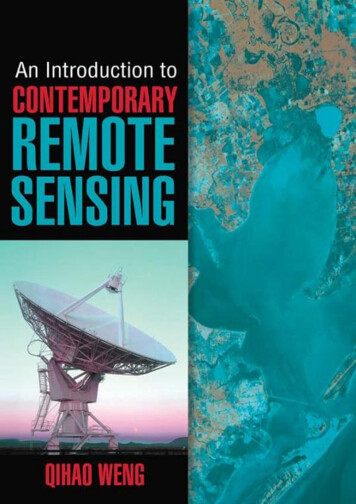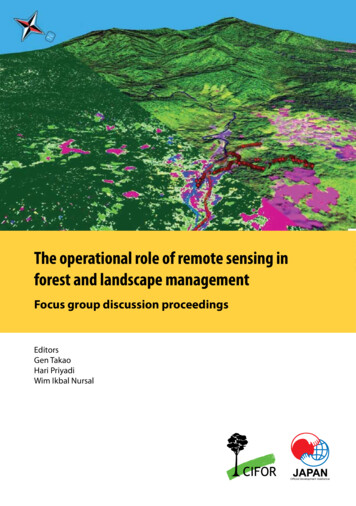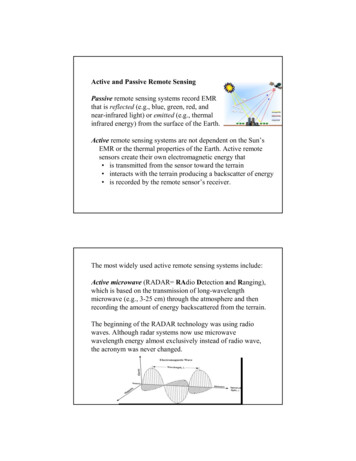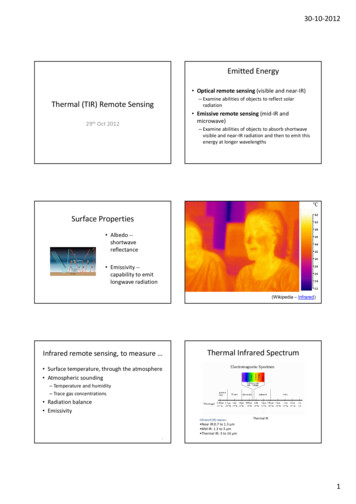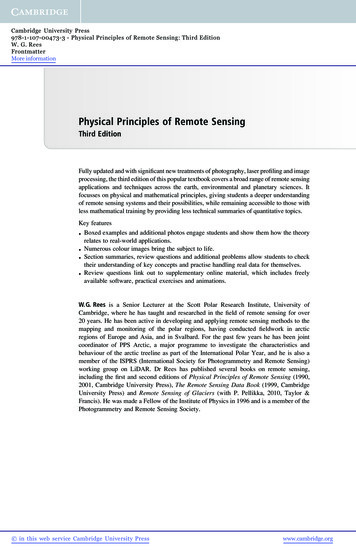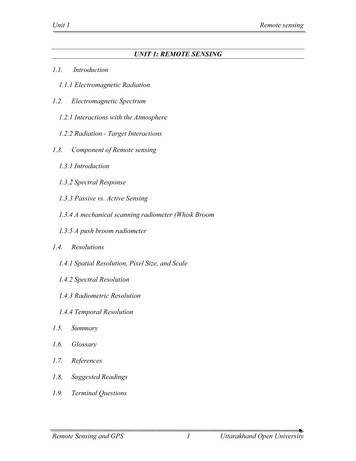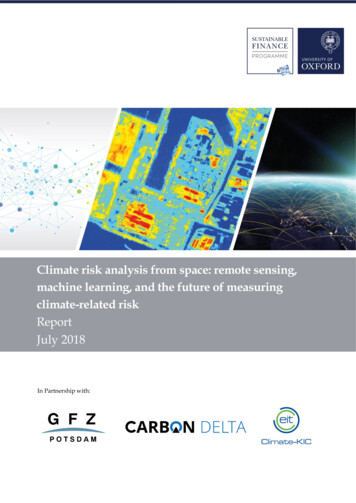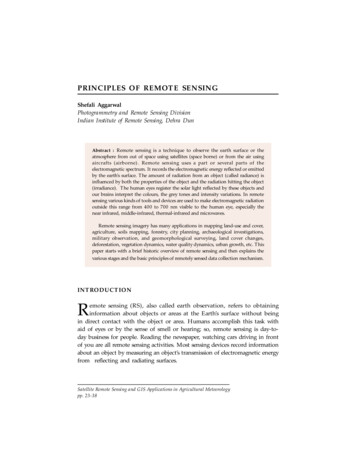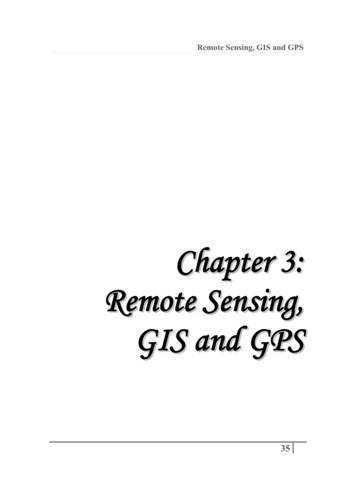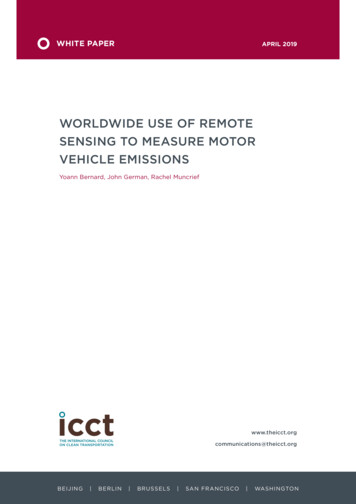
Transcription
WHITE PAPERAPRIL 2019WORLDWIDE USE OF REMOTESENSING TO MEASURE MOTORVEHICLE EMISSIONSYoann Bernard, John German, Rachel E I JI N G BERLIN B R U SS E LS SAN FRANCIS CO WAS H INGTO N
ACKNOWLEDGMENTSThe authors thank participants in the survey; Uwe Tietge for help developing the maps;Liuhanzi Yang for help getting information from China; and Tim Dallmann, Karl Ropkins,Javier Buhigas, and Niranjan Vescio from OPUS and Stewart Hager from HEAT for theircritical reviews.This study was funded through the generous support of the European Climate Foundation.International Council on Clean Transportation1555 K Street NW, Suite 650Washington, DC 20006 USAcommunications@theicct.org www.theicct.org @TheICCT 2019 International Council on Clean Transportation
WORLDWIDE USE OF REMOTE SENSING TO MEASURE VEHICLE EMISSIONSINTRODUCTIONDevelopment and use of remote vehicle emissions sensing has been growing in recentyears. Early systems were pioneered by the University of Denver, funded initially bythe Colorado Office of Energy Conservation and later by the California Air ResourcesBoard (CARB) in the late 1980s. In the past decade, use of remote sensing has increaseddramatically, especially in China.Vehicle remote sensing technologies are emission-measurement systems that do notphysically interact with the vehicle undergoing testing. Unlike testing using chassisdynamometers or portable emission measurement system (PEMS), where vehicle tailpipeemissions are directly measured, remote sensing measures pollutant concentrations ina vehicle’s exhaust plume via spectroscopy as the vehicle drives through a light beamor, alternatively, extracts a sample from the exhaust plume to measure with pollutantanalyzers. The first method is much more prevalent and is the primary focus of thispaper. Throughout this paper we refer to the first method as “open path” remote sensingand the second as “extractive” remote sensing.This paper details the current state of remote sensing technology, research, anddeployment around the world, with a particular focus on evaluating barriers to itswidespread deployment.APPLICATIONS OF REMOTE SENSING DATAConceptually, remote sensing technology is in certain respects the opposite oflaboratory and PEMS testing (see Figure 1). Laboratory and PEMS testing can collectmassive amounts of emissions data on a single vehicle, but the testing is too timeconsuming and expensive to perform on large numbers of vehicles. The snapshot of theexhaust plume content collected by open path remote sensing from a passing vehicle isequivalent to about one second’s worth of emissions data,1 but thousands of vehicles canbe measured in a single day. Combined with the nonintrusive nature of remote sensing,as the vehicle does not detect that it is being tested, remote sensing is a particularlysuitable solution for market surveillance. With enough measurements, remote sensingcan be used to statistically quantify the emissions of individual vehicle models, evaluatethe impacts of environmental and driving conditions, monitor older as well as newervehicles, and track the effects of aging, deterioration, malfunctions, and recalls.Remote sensing is potentially the best option for:»» Determination of granular fleetwide emissions factors to assist local governmentsin policymaking decisions, such as the establishment of vehicle restriction measuressuch as low-emissions zones, or vehicle bans, or the development of vehiclescrappage and renewal programs.»» Development of emissions factors to use as inputs in determining emissions inventories.»» Monitoring of overall fleet emission trends.»» Identification of high-emitting vehicle groups for market surveillance and follow-upregulatory compliance activities.»» Utilization of real-world vehicle emissions data to inform new customerpurchase decisions.1Certain extractive remote sensing techniques may collect hundreds of seconds of data while gathering dataon fewer vehicles per day.1
ICCT WHITE PAPER»» Identification of individual low-emitting vehicles, for a “clean screen” programwhereby properly functioning vehicles can bypass annual technical inspections.2»» Identification of individual high-emitting vehicles for triggering early technicalinspections or for tampering detection.Remote SensingChassis dynamometer Fleet screening Fixed monitoring networkor targeted sampling campaigns Hundreds of thousands tomillions of individual vehicleemissions measurements Controlled testing toascertain causes ofhigh emissionsPEMS Limited number ofvehicles tested Basis forenforcementactionsHigh numbers of the samevehicle model identified ashigh emitters may be indicativeof systematic flaw and wouldwarrant follow-up testingSuspicious vehicle modelIndividual high emitter Follow-up actionsto encouragevehicle repairIndividual low emitter Cleanest vehiclesare exempted fromthe next periodicalemission inspectionFigure 1: Possible applications of vehicle remote sensing in an enhanced vehicle emissionscontrol program.REMOTE SENSING EMISSIONS MEASUREMENT METHODSThe two main types of remote sensing technologies are described below.Open path systems (see Figure 2): A light source and light detector are placed eitherat the side of or above a roadway, and the light source is reflected back by a mirror orreflective strip on the other side. The light absorbed by the exhaust plume as the lightpasses through is measured and correlated to the concentration of certain pollutants inthe exhaust plume. The pollutant concentration as measured before the vehicle crossesthe light beam is taken as background pollution and subtracted from the measurement.The system also includes speed and acceleration detectors and a license plate camera.All systems currently use infrared and ultraviolet light sources through arc lamp, suchas xenon, or lasers. The use of lasers as the light source can increase the sampling rate2The ability to identify individual vehicle emissions could also be used in the future to identify and allow cleanvehicles to enter a low-emission zone without charge.2
WORLDWIDE USE OF REMOTE SENSING TO MEASURE VEHICLE EMISSIONSalong an individual exhaust plume from about 100 times per second to more than 10,000times per second, potentially improving speed and accuracy.3Either light source can theoretically be used in either configuration (Figure 2), althoughit is more common for the overhead system to employ a laser light source and thecross-road system to employ an arc lamp source. Overhead systems work similarly tocross-road systems and are capable of conducting measurements at sites with multiplelanes as well as collecting measurements from any vehicle independently of exhauststack height. Cross-road systems must be positioned in line with the height of theexhaust stack.Data processing& video displaySource &detector module& weather sensorSpeed &Video camera &acceleration license plate readerdetectorSource & detectormodule & dataprocessingWeathersensorCamera(speed &license plate)Reflector stripLateral transfermirrorFigure 2: Schematic setup of the three units of the remote sensing device. Left, setup for cross-roadremote sensing: the light source with the reflecting mirror at the other side of the road and the lightdetector, the speed and acceleration detectors, and the plate number recorder. Right, setup fortop-down remote sensing system.Note: Figure modified from Jens Borken-Kleefeld and Tim Dallmann, Remote Sensing of MotorVehicle Exhaust Emissions (ICCT, February 2018), ations/Remote-sensing-emissions ICCT-White-Paper 01022018 vF rev.pdf.Extractive systems (Figure 3a and Figure 3b): Extractive remote sensing capturesa portion of the target vehicle exhaust plume and directs that exhaust to pollutantanalyzers to measure exhaust concentrations. An advantage is that the precision ofthe pollutant measurement is limited only by the complexity of the analyzers. However,extractive remote sensing systems can measure fewer vehicles in a given amount of timethan open path systems, depending on the sampling technique selected.3Note that the laser’s faster exhaust sampling rate may not yield useful improvements of the vehicle fleetsampling rate if remote sensing devices using arc lamps are fast enough to measure every vehicle that goes by.3
ICCT WHITE PAPERMultiple techniques have been devised for capturing the exhaust, including:1.Exhaust plume chaser (Figure 3a): A vehicle equipped with on-board emissionanalyzers chases vehicles while sampling the air behind them. A portion of the targetvehicle exhaust plume is captured using a sampling line with its inlet on the exteriorof the chase vehicle. This exhaust sample is routed to pollutant analyzers to measureexhaust concentrations.2.Stationary air sampling (Figure 3b): The air in the vicinity of the exhaust’s plume isactively aspirated. The measurement method is similar to the plume chaser, exceptthat target vehicles drive past a fixed sampling location with sampling inlets placedin close proximity to the tailpipes/exhaust stacks of passing vehicles. The schematicin Figure 3b is a stationary air sampling system optimized for heavy-duty vehicles.Updraftexhaust igure 3a: Schematic setup of a plume chaser installed in vehiclemeasuring the exhaust emissions from the truck in frontDowndraftexhaust intakeFigure 3b: Schematic setup of a stationary air sampling system.REMOTE SENSING MANUFACTURERS AND CAPABILITIESThe first open path cross-road arc lamp systems were pioneered by Gary Bishop andDonald Stedman of the University of Denver, funded initially by the Colorado Office ofEnergy Conservation and later by the California Air Resources Board in the late 1980s.4The original system, called the Fuel Efficiency Automotive Test (FEAT), was used toidentify gasoline vehicles with high carbon monoxide (CO) emissions for repair, withthe goal of both reducing in-use emissions and improving fuel efficiency. The systemswere later commercialized by Envirotest and more recently by OPUS Group under thebrand AccuScan.5 The RSD 5000 is the latest remote sensing device from OPUS. It addsnitrogen dioxide (NO2) to pollutants detected by the earlier RS 4600 device—nitrogenmonoxide (NO), CO, carbon dioxide (CO2),6 hydrocarbons (HC), and opacity. While laserbased analyzers have been used for 20 years for on-road remote sensing,7 a relativelyrecent innovation is the EDAR instrument commercialized by HEAT. This system uses alaser light source along with reflective strips placed in or on the road surface to enabletop-down open path remote sensing. In addition, the EDAR system has the capability toscan a two-dimensional image of the exhaust plume. This has the potential to allow foran absolute measurement of each pollutant, as compared with measuring each pollutantas a ratio to CO2. This particular laser-based system also has the ability to measureexhaust gas temperature.4Donald H. Stedman et al., “On-Road CO Remote Sensing in the Los Angeles Basin” (California Air ResourcesBoard, 1989), pdf.Envirotest is now a subsidiary of OPUS providing testing services in the US while the operational hub inEurope is Opus Remote Sensing Europe (OpusRSE) in Madrid.Note that while open path remote sensing measures CO2 absorption, it is not necessarily able to quantifyCO2 emissions or fuel consumption. Typically the CO2 value is used so that the other pollutants can bereported on a fuel-specific basis.D.D. Nelson, M.S. Zahniser, J.B. McManus, C.E. Kolb, J.L. Jiménez, “A Tunable Diode Laser System for theRemote Sensing of On-Road Vehicle Emissions,” Applied Physics B 67, no. 4 (October 1, 1998): 4ALPR
WORLDWIDE USE OF REMOTE SENSING TO MEASURE VEHICLE EMISSIONSWhile China started using remote sensing much later than the United States, Chineseauthorities now test far more vehicles with remote sensing than any other country.Domestic manufacturers have developed to supply this market. These manufacturersinclude Environmental Technology Consultants (ETC) in Hong Kong, which makes abattery-powered portable arc lamp system,8 and Dopler,9 which offers roadside andoverhead laser-light systems in China. Anhui Baolong10 has an overhead arc lamp systeminstalled in many locations in China.11 Note that the overhead remote sensing equipmentfrom Dopler and Baolong monitor CO, CO2, HC, and NO, but not NO2.Extractive remote sensing systems are less widely available than open path systems.While there are no commercialized systems readily available on the market, regulatoryand academic researchers have created their own systems. Researchers from theUniversity of California, Berkeley, have used the extractive measurement technique tocharacterize the benefits of various emissions control technologies for trucks in the Portof Oakland.12 CARB has developed and used a system called the Portable EmissionsAcquisition System (PEAQS).13 PEAQS captures a portion of the emissions from passingheavy-duty vehicles and calculates a fuel-specific emissions snapshot, or the amount ofpollutant per unit of fuel burned, for total NOx and black carbon, which is a large fractionof diesel particulate emissions. The University of Denver had earlier developed a similarprinciple, the On-road Heavy-duty Monitoring System (OHMS), that used a portable shedto improve the capture and analysis of fuel-specific emissions.14 In Europe, the Universityof Münster15 and the Czech Technical University16 have developed stationary extractivesampling systems that capture a portion of the exhaust plume of passing vehicles.CARB has also developed a plume chasing system. The agency equipped a zeroemission vehicle with plume-chasing capabilities to measure CO, NOx, and particulatematter (PM) from light-duty gasoline vehicles as well as heavy-duty diesel trucks.17The University Heidelberg developed a plume chaser to identify trucks that use illegalsystems to deactivate NOx emission controls.18 The University of Birmingham developeda special configuration of its Mobile Air Monitoring Laboratory (MAML) operated as a89101112131415161718“Remote Sensing System,” ETC Remote sensing system, accessed April 3, 2019, ��技有限公司,” [Dopler Environmental Technology Co., Ltd.], Dopler Eco Technologies Co. Ltd.,accessed April 3, 2019, http://www.dopler.com.cn/productsd.php?tid 3&id 49.“Baolong Dedicated to Vehicle Emissions Remote Sensing for Clean Air,” Tsinghua Holdings, accessed April3, 2019, c 100754.htm.Other Chinese remote-sensing suppliers are Nanjing Xinyuanjian, Beijing Huaqing, Changsha Shijie, AnhuiQingyu, Hebei Xianhe, Guangzhou Yunjing, Tianjin Shengwei, Tianjin Tongyang, Zhejiang Univ. Mingquan,Runcheng Tech, Shenzhen Anche, Shantou Shengfei’er and Dongruan Group.Chelsea V. Preble et al., “Effects of Particle Filters and Selective Catalytic Reduction on Heavy-Duty DieselDrayage Truck Emissions at the Port of Oakland,” Environmental Science & Technology 49, no. 14 (July 21,2015): 8864–71, https://doi.org/10.1021/acs.est.5b01117.Jeremy D. Smith et al., “Quantification of HD In-Use Vehicles Using the Portable Emissions AcQuisition System(PEAQS)” (28th CRC Real world emissions workshop: California Air Resources Board, March 18, 2018), Present/JeremySmith CARBCRC Presentation.pdf.Gary A. Bishop and Molly J. Haugen, “Investigate the Durability of Diesel Engine Emission Controls,”(University of Denver, March 2018), http://www.feat.biochem.du.edu/assets/reports/DU CARB OHMSFinal Report v8.pdf.Christian Peitzmeier et al., “Real-World Vehicle Emissions as Measured by in Situ Analysis of ExhaustPlumes,” Environmental Science and Pollution Research 24, no. 29 (October 2017): 23279–89, https://doi.org/10.1007/s11356-017-9941-1.Michal Vojtíšek, Jan Skácel, and Vít Beránek, “Roadside Measurement of PM/PN Emissions from IndividualVehicles in Prague,” 2018, 23.Seong Suk Park et al., “Emission Factors for High-Emitting Vehicles Based on On-Road Measurements ofIndividual Vehicle Exhaust with a Mobile Measurement Platform,” Journal of the Air & Waste ManagementAssociation 61, no. 10 (October 1, 2011): 1046–56, https://doi.org/10.1080/10473289.2011.595981.D. Pöhler and T. Engel, “Bestimmung von LKW NOx Emissionen [Real Driving Emissions] Auf TirolerAutobahnen Und Potenziellen Abgasmanipulationen” [Determination of truck real driving NOx emissionson Tyrolean motorways and potential emissions manipulation] (Institut für Umweltphysik, UniversitätHeidelberg, November 5, 2018).5
ICCT WHITE PAPERcar chaser called SNIFFER.19 Other plume chaser solutions are being used for researchapplications in China,20 Finland,21 Slovenia,22 and Mexico.23Table 1 summarizes the main open path and extractive remote sensing technologiesand manufacturers.Table 1: Main remote sensing technologies and manufacturers.TypePositionProvider / InventorEquipment nameCross-roadUniversity of ogyConsultantsR-series S650Arc lamp light beamwith mirror reflectorCO, CO2, HC, NO, NO2Cross-road;OverheadDopler EcoTechnologiesDPL7000 SeriesLaser light beam withmirror reflectorCO, CO2, HC, NO, opacityOverheadHEAT LLCEDARLaser curtain with stripreflectorCO, total and speciatedHC, CO2, NO, NO2, opacityOverheadAnhui BaolongArc lamp light beamwith mirror reflectorCO, CO2, HC, NO, opacityOverheadsamplingUniversity ofCalifornia, BerkeleyExhaust plume sampleCH4, NO, NO2, NH3 BC,PM, PN, PN size,OverheadsamplingCARBPortable EmissionsAcquisition System(PEAQS)Exhaust plume sampleBlack carbon and NOxOverheadsampling inShedUniversity of DenverOHMSExhaust plume sampleCO, CO2, HC, NO, NO2,N2O, PM, PN, BlackCarbonRoadsidesamplingCzech TechnicalUniversityExhaust plume sampleCO, CO2, NOx, PM, PNRoadsidesamplingUniversity ofMünsterExhaust plume sampleNOx, CO2, PNPlume chaserUniversity ofHeidelbergICADExhaust plume sampleNO, NO2, CO2Plume chaserUniversity ofBirminghamSNIFFERExhaust plume sampleNO, NO2, CO2Plume chaserCARBMobile MeasurementPlatform (MMP)Exhaust plume sampleCO, CO2, HC, NOx, PM, PN,Black CarbonFEATRSD 4600 and olderOpen pathExtractiveRSD 5000MeasurementArc lamp light beamwith mirror reflectorArc lamp light beamwith mirror reflectorMeasuresCO, HC, CO2, NO, NO2,NH3, SO2, opacityCO, HC, CO2, NO, opacityCO, HC, CO2, NO, NO2,NH3, opacity19 Karl Ropkins et al., “Evaluation of EDAR Vehicle Emissions Remote Sensing Technology,” Science of The TotalEnvironment 609 (December 2017): 1464–74, https://doi.org/10.1016/j.scitotenv.2017.07.137.20 Xing Wang et al., “On-Road Diesel Vehicle Emission Factors for Nitrogen Oxides and Black Carbon inTwo Chinese Cities,” Atmospheric Environment 46 (January 1, 2012): 45–55, https://doi.org/10.1016/j.atmosenv.2011.10.033.21 Liisa Pirjola et al., “Physical and Chemical Characterization of Real-World Particle Number and MassEmissions from City Buses in Finland,” Environmental Science & Technology 50, no. 1 (January 5, 2016): 294–304, https://doi.org/10.1021/acs.est.5b04105.22 I. Ježek et al., “Black Carbon, Particle Number Concentration and Nitrogen Oxide Emission Factors ofRandom In-Use Vehicles Measured with the on-Road Chasing Method,” Atmospheric Chemistry and Physics15, no. 19 (October 5, 2015): 11011–26, https://doi.org/10.5194/acp-15-11011-2015.23 Miguel Zavala et al., “Emission Factors of Black Carbon and Co-Pollutants from Diesel Vehicles inMexico City,” Atmospheric Chemistry and Physics 17, no. 24 (December 22, 2017): 15293–305, https://doi.org/10.5194/acp-17-15293-2017.6
WORLDWIDE USE OF REMOTE SENSING TO MEASURE VEHICLE EMISSIONSMETHODOLOGYTo detail the current state of remote sensing technology, research, and deploymentaround the world, information on worldwide remote sensing activities was gathered. Theinformation comes mainly from the results of a survey we initiated in September 2018and was supplemented by additional information to which the ICCT has access, such asin-house databases and published literature.The ICCT sent surveys to all organizations that we were aware might be workingon remote sensing around the world. This included remote sensing equipmentproviders, researchers, and city, state, and country governments and authorities. All28 questionnaires were completed and returned. In some cases, surveys were followedup by email or phone interviews to clarify responses. The survey responses includedremote sensing technologies used, purposes of the testing, pollutants measured, typesof vehicles targeted, number of vehicles tested, cities in which testing was conducted,testing conditions, vehicle information collected, and current challenges for the useof remote sensing (see detailed survey questions in Appendix A). We asked surveyrespondents to focus on remote sensing work since 2010 to capture the most recentdevelopments.7
ICCT WHITE PAPERWORLDWIDE REMOTE SENSING SUMMARYDATA COLLECTION LOCATIONS AND ACTIVITIESFigure 4 presents countries where remote sensing data collection has taken placesince 2010 based on our findings. Data has been collected from all continents exceptAntarctica, with more than 1 million measurements per year collected in China, theUnited States, Hong Kong, and Korea, and more than 1 million measurements since 2010in India. In Europe, data collection activities have been mostly in western countries—withmore than 1 million measurements since 2010 in Spain—and northern countries. Therealso have been a few activities in Bulgaria, the Czech Republic, and Slovenia. Ghana isthe only African country were remote sensing was found.Figure 4: Countries where remote sensing has been used since 2010 in dark blue.Table 2 presents an overview by country that includes the remote sensing technologyused, the types of vehicles measured, the application that was the focus of the work, andthe range of individual measurements since 2010.8
WORLDWIDE USE OF REMOTE SENSING TO MEASURE VEHICLE EMISSIONSTable 2: Overview of the different remote sensing technologies, type of vehicles measured, and programs that took place indifferent countries since 2010.CountryTechnologyType of vehicles measuredNumber of individualmeasurements since 2010Use of RMOAustriaCPCLCVHDVRMOH10,000 - 100,000BulgariaCPCLCVHDVMOH10,000 - rkASACFinlandSCGermanyCGhanaCPCLCVHDVHong VHDVKoreaCPCMexicoCNew USACOAAMOMCRMC10,000 - 100,00010,000 - 100,000MSMOROFFH 1,000,00010,000 - 100,000RR10,000 - 100,000MOH10,000 - 100,000RMCMC 10,000100,000 - HDVRMO 1,000,000 1,000,000H10,000 - 100,000MOMC10,000 - 100,00010,000 - 100,000100,000 - 1,000,000HPC10,000 - 100,00010,000 - 100,000MOHDVFranceOMCH 1,000,000L100,000 - 1,000,000100,000 - 1,000,000RMC 10,000RMORMOH 1,000,00010,000 - 100,000PCLCVHDVMCRMOMS100,000 - 1,000,000SPCLCVHDVMCRMOMS100,000 - 1,000,000SPCLCVHDVMCRMOMS 1,000,000OFFHLC: Cross-road (open path) systemO: Overhead (open path) systemA: Extractive air sampling at a fixed locationS: Extractive air sampling from a car (plume chaser or sniffer)PC: Passenger CarLCV: Light-commercial vehicles, such as vans and pickup trucksHDV: Heavy-duty vehiclesMC: MotorcyclesOFF: Off-road equipmentR: ResearchMO: Monitoring of fleet emissionsH: Identification of individual high emitters for inspections or tamperingL: Identification of individual low emitters for a “clean screen” programMS: Identifying groups of high emitting vehicles for market surveillance9
ICCT WHITE PAPERPOLLUTANTS MEASUREDThe pollutants measured varied across the different remote sensing testing programs.The large majority measured nitrogen oxide (NO), HC, and CO2 while more than half theprograms measured NO2, CO, and some measure of particulates. Total particulate matterbased on opacity was the most commonly measured indicator of PM. Only campaignsusing extractive techniques were able to measure black carbon, particulate number,and/or particulate size distribution. Other pollutants that were measured less frequentlyinclude ammonia (NH3), sulfur dioxide (SO2), nitrous oxide (N2O), and methane (CH4).REMOTE SENSING TECHNOLOGY USEOpen path systems were by far the most widely and commonly used. Cross-roadsystem configurations were used by 24 of the 27 countries in which remote sensingwas deployed, while the overhead configuration was used in 5 of the 27. Five countriesemployed both configurations. Note that in the majority of cases, the cross-road systemsused arc lamps, and the overhead systems, lasers. In China there were also overheadsystems using arc lamps and cross-road systems with lasers.Programs in seven countries used extractive sampling from a car, or exhaust plumechaser, and six used extractive sampling at a stationary location.APPLICATIONS OF REMOTE SENSING DATAPrograms in more than three-quarters of countries used data from remote sensing tomonitor fleet emissions. Slightly less than three-quarters of the countries used the datafor research, such as determining emissions control deterioration rates and evaluatingon-road performance of various vehicle technologies.The next most-frequent use was identifying individual high- or low-emitting vehicles orgroups of high-emitting vehicles. Programs in some U.S. states, China, Hong Kong, Korea,Canada, Mexico, Austria, Iran, Bulgaria, Germany, Spain, and Denmark used or plannedto use remote sensing to identify individual high emitters for triggering early periodicaltechnical Inspections or for tampering detection. Programs in the U.S. states of Virginia,Colorado, Ohio, and a recent project in the city of Nashville in Tennessee also usedremote sensing to identify individual low emitters for a “clean screen” program, in whichlow-emitting vehicles are exempted from periodic technical inspectionsEven less common were programs that used remote sensing to inform regulatorycompliance. Programs in the United States,24 Hong Kong, Canada, Switzerland, Germany,and the United Kingdom used remote sensing data to demonstrate the feasibility ofidentifying groups of high-emitting vehicles for market surveillance. High-emittinggroups of vehicles identified by remote sensing can be subject to further compliancetesting and potential enforcement actions.CHINA: SUMMARY OF ACTIVITIESActivities in China are of particular interest because of the extensive amount of remotesensing data that is being gathered and the potential applications for it. Remote sensingactivities in China focused primarily on detection of individual high-emitting vehicles.25China has had the largest amount of remote sensing activity in the world since 2017with close to 260 permanent open path systems recording about 38 million vehicle24 Carl Fulper et al., “Remote Sensing Data (RSD) From the State of Colorado: ‘Real-World’ Emission Analysison Newer Vehicles,” 2017, 20.25 Zifei Yang, “Remote-Sensing Regulation for Measuring Exhaust Pollutants from In-Use Diesel Vehicles inChina” (ICCT, September 19, 2017), ations/China-dieselremote-sensing ICCT-policy-update 19092017 vF.pdf.10
WORLDWIDE USE OF REMOTE SENSING TO MEASURE VEHICLE EMISSIONSmeasurements during 2017 alone.26 Most of the remote sensing campaigns were in theJing-Jin-Ji region, which is the densely populated area surrounding Beijing, Tianjin,and Hebei and used a total of 126 systems as of late 2017. Beijing, Tianjin, and 26 othercities in China were required to establish remote sensing platforms by the end of 2017.27At that time, 22 out of 31 provinces in China were using remote sensing (detailed inAppendix B). More recently, Sichuan province installed remote sensing units in the city ofChengdu.28 According to the Three-Year Action Plan on Winning the Battle for Blue Sky,China’s State Council put in place a requirement to extend the establishment of remotesensing platforms in the Jing-Jin-Ji area to the other key regions of the Yangtze RiverDelta and Fen-Wei Plain by the end of 2018.29 By the end of 2018, more than 560 remotesensing units were in active use across China in 23 provinces.Figure 5 shows the locations of remote sensing activities in China as of late 2018.Appendix B details the number of measurements in 2017 by province and whether selectcities are subject to mandatory monitoring.Not usedUsedCompulsory inselect citiesFigure 5: Location of remote sensing activities across China by the end of 2018. More informationcan be found in Appendix B.26 MEE, “China Vehicle Environmental Management Annual Report 2018,” 2018, http://www.vecc.org.cn/180601/1-1P601164953.pdf.27 MEE, ��气污染防治工作方案》的通知,” [2017 Jing-Jin-Ji Air PollutionPrevention and Control Plan], March 23, 2017, http://dqhj.mee.gov.cn/dtxx/201703/t20170323 408663.shtml.28 Chengdu EPB, “成都市机动车遥感监测平台及 ‘黑烟车’抓拍系统介绍,” [Chengdu Motor Vehicle Remote SensingMonitoring Platform and ‘Black Smoke Vehicle’ Capture System], 2019, D%A6%E4%B8%8E%E9%81%A5%E6%84%9FV1.pdf.29 China State Council, �行动计划的通知(国发〔2018〕22号,” [Three-Year ActionPlan on Winning the Battle for Blue Sky], June 27, 2018, nt 5303158.htm.11
ICCT WHITE PAPERUNITED STATES: SUMMARY OF ACTIVITIESRemote sensing activities in the United States are also significant. The University ofDenver was an early pioneer in remote sensing activities with the FEAT system, andU.S.-based organizations have developed a number of m
such as low-emissions zones, or vehicle bans, or the development of vehicle scrappage and renewal programs. » Development of emissions factors to use as inputs in determining emissions inventories. » Monitoring of overall fleet emission trends. » Identification of high-emitting vehicle groups for market surveillance and follow-up
